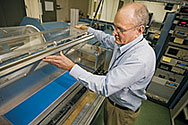Low-drag suit propels swimmers
 Competition in the pool at this month’s Beijing Olympics will be not only among world-class swimmers but also their swimsuits. Since its debut in February, the low-drag hydrophobic Fastskin LZR Racer swimsuit from Speedo International Ltd has had more than 44 world records broken in it; critics allege that the $600 «space-age» suit, in part developed by NASA scientists, gives its wearers an unfair boost in buoyancy and amounts to «technological doping.» The company claims a 5% decrease in drag over the previous model but no buoyancy increase, and the suit, along with competing models, has been approved for Olympic competition by FINA, the international swimming federation.
Competition in the pool at this month’s Beijing Olympics will be not only among world-class swimmers but also their swimsuits. Since its debut in February, the low-drag hydrophobic Fastskin LZR Racer swimsuit from Speedo International Ltd has had more than 44 world records broken in it; critics allege that the $600 «space-age» suit, in part developed by NASA scientists, gives its wearers an unfair boost in buoyancy and amounts to «technological doping.» The company claims a 5% decrease in drag over the previous model but no buoyancy increase, and the suit, along with competing models, has been approved for Olympic competition by FINA, the international swimming federation.
The LZR Racer is a descendant of the full-body swimsuit Speedo introduced in 2000 to mimic the viscous-drag-reducing denticles on a shark’s skin. The shark suit proved that surface-engineered synthetic materials can be made to have lower drag than a swimmer’s shaved skin. The next move for Speedo’s internal R&D unit was to form a team of external partners led by Barry Bixler, the late Honeywell Corp engineer and computational fluid dynamics (CFD) expert, to further cut the passive drag.
NASA aerospace engineer Stephen Wilkinson joined the team in 2005 after Bixler suggested that NASA’s aerodynamic testing of materials would provide valuable data for CFD simulations used to model the fluid flow profile around the swimmer–swimsuit system. Wilkinson measured the skin-friction coefficient of more than 60 fabrics in a low-speed wind tunnel with a cross section of 18 × 28 cm at the Langley Research Center’s flow physics and control branch. The results led Speedo to go with lightweight woven elastane-nylon as the base fabric of the LZR Racer.
 With the new suit, Speedo abandoned denticles and turned its focus to minimizing form drag, which is due to body shape. «There is still debate as to what the primary source of drag is for a shark, but for a swimmer, it is primarily form drag,» says Amy Lang, an experimental fluid dynamicist at the University of Alabama. From CFD simulations and studies in a swimming flume, the researchers determined that total drag is reduced when low-drag polyurethane panels are inserted to compress the chest, upper thighs, and other areas of the swimmer’s body where form drag is most pronounced. «We spent a lot of time [on the previous model] drag testing anatomically accurate mannequins» in the flume, says David Pease, a biomechanist at the University of Otago in New Zealand. «This time around involved quite a bit more actual athlete testing in order to test differences in compression and support provided by the new suit.»
With the new suit, Speedo abandoned denticles and turned its focus to minimizing form drag, which is due to body shape. «There is still debate as to what the primary source of drag is for a shark, but for a swimmer, it is primarily form drag,» says Amy Lang, an experimental fluid dynamicist at the University of Alabama. From CFD simulations and studies in a swimming flume, the researchers determined that total drag is reduced when low-drag polyurethane panels are inserted to compress the chest, upper thighs, and other areas of the swimmer’s body where form drag is most pronounced. «We spent a lot of time [on the previous model] drag testing anatomically accurate mannequins» in the flume, says David Pease, a biomechanist at the University of Otago in New Zealand. «This time around involved quite a bit more actual athlete testing in order to test differences in compression and support provided by the new suit.»
The Olympic-ready design of the swimsuit is based on three-dimensional volumetric body scans of some 400 elite swimmers and the results of tests with prototypes at the Australian Institute of Sport. Instead of being stitched together, the various segments of the swimsuit are bonded by ultrasonic acoustic vibrations—a first for swimwear. «It’s a complicated process to produce a fast swimsuit and that’s why it took [nearly] four years to produce the LZR Racer,» says Jason Rance, Speedo’s head of innovation.
Speedo’s external CFD expert, University of Nottingham fluid mechanist Hervé Morvan, says that the company’s R&D collaboration is already looking to reduce active drag in preparation for the 2012 London Olympics. FINA will no doubt face mounting pressure to address advances in swimwear innovation. Some competitive swimming enthusiasts wonder whether the sport is becoming more like drag racing or golf, in which equipment is often as important as human skill, while skeptics say drag-reducing technologies offer at best a psychological advantage for swimmers. But for a sport in which the difference between winning and losing is often on the order of a hundredth of a second, any reduction in resistance is appreciated, says Iowa State University exercise physiologist Rick Sharp, who leads Speedo’s external R&D team. «After the excitement dies down from the Olympic Games, what I hope the swimming community learns is that this suit has taught us that we stand far more to gain from drag reduction than we previously realized.»
Jermey N. A. Matthews
